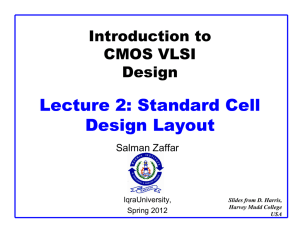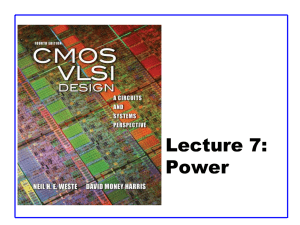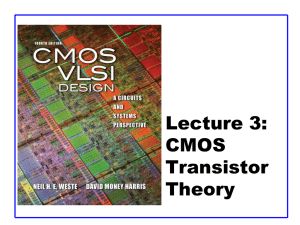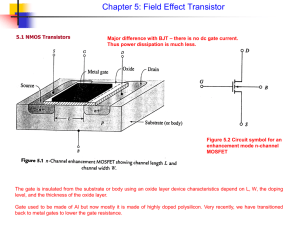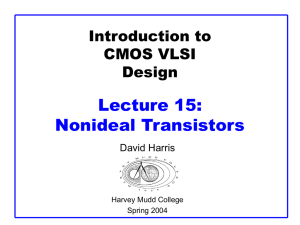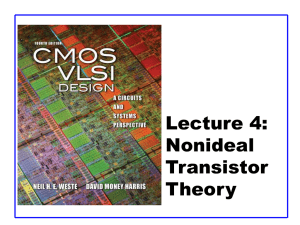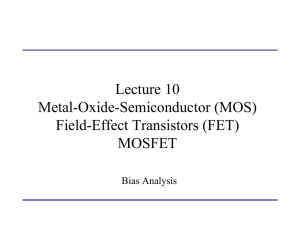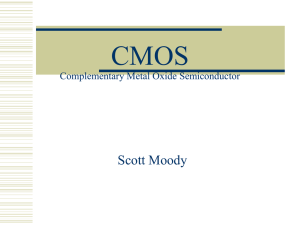Nonideal transistor
advertisement
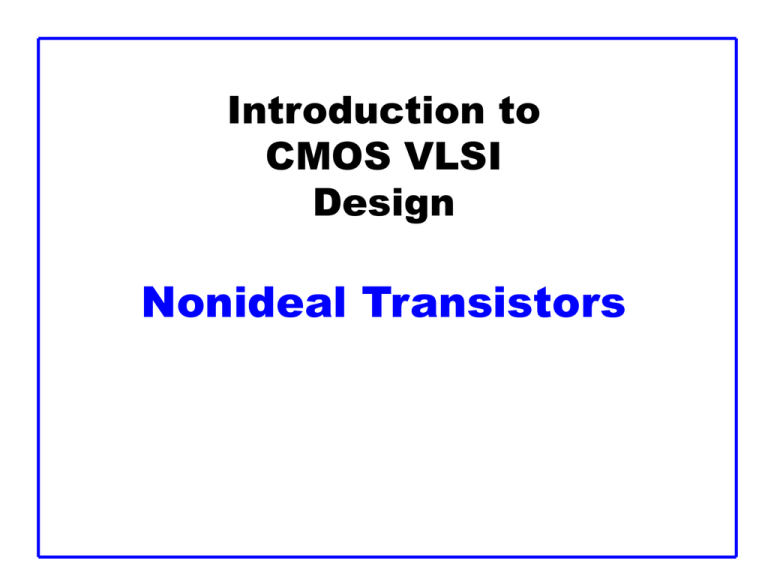
Introduction to CMOS VLSI Design Nonideal Transistors Outline Transistor I-V Review Nonideal Transistor Behavior – Velocity Saturation – Channel Length Modulation – Body Effect – Leakage – Temperature Sensitivity Process and Environmental Variations – Process Corners CMOS VLSI Design 2 Ideal Transistor I-V Shockley 1st order transistor models 0 Vds I ds Vgs Vt 2 2 Vgs Vt 2 Vgs Vt V V V ds ds dsat Vds Vdsat cutoff linear saturation Vdsat = Vgs - Vt CMOS VLSI Design 3 Ideal nMOS I-V Plot 180 nm TSMC process Ideal Models – = 155(W/L) mA/V2 – Vt = 0.4 V – VDD = 1.8 V = mnCox(W/L) Ids (mA) 400 300 Vgs = 1.5 200 Vgs = 1.2 100 0 CMOS VLSI Design Vgs = 1.8 Vgs = 0.9 Vgs = 0.6 0 0.3 0.6 0.9 1.2 1.5 1.8 Vds 4 Simulated nMOS I-V Plot 180 nm TSMC process BSIM 3v3 SPICE models – very elaborate model derived from the underlying Ids (mA) device physics What differs? 250 Vgs = 1.8 200 Vgs = 1.5 150 Berkeley Short-Channel IGFET Model (BSIM) Vgs = 1.2 100 Vgs = 0.9 50 Vgs = 0.6 0 0 0.3 0.6 0.9 1.2 1.5 Vds CMOS VLSI Design 5 Simulated nMOS I-V Plot 180 nm TSMC process BSIM 3v3 SPICE models What differs? I (mA) – Less ON current 250 – No square law 200 – Current increases 150 in saturation 100 ds Vgs = 1.8 Vgs = 1.5 Vgs = 1.2 Vgs = 0.9 50 Vgs = 0.6 0 0 0.3 0.6 0.9 1.2 1.5 Vds CMOS VLSI Design 6 Velocity Saturation We assumed carrier velocity is proportional to E-field – v = mElat = mVds/L At high fields, this ceases to be true – Carriers scatter off atoms – Velocity reaches vsat • Electrons: 6-10 x 106 cm/s • Holes: 4-8 x 106 cm/s / 2 – Better model sat sat μElat v vsat μEsat Elat 1 Esat CMOS VLSI Design slope = m 0 0 Esat 2Esat 3Esat Elat 7 Velocity Sat I-V Effects Ideal transistor ON current increases with V2 2 W Vgs Vt I ds mCox Vgs Vt L 2 2 2 Velocity-saturated ON current increases with V I ds CoxW Vgs Vt vmax Real transistors are partially velocity saturated – Approximate with a-power law model – Ids Va – 1 < a < 2 determined empirically CMOS VLSI Design 8 a-Power Model 0 V I ds I dsat ds Vdsat I dsat Vgs Vt cutoff I dsat Pc Vds Vdsat linear Vds Vdsat saturation V 2 gs Vt a Vdsat Pv Vgs Vt a /2 Simulated a-law Shockley Ids (mA) 400 300 Vgs = 1.8 200 Vgs = 1.5 CMOS VLSI Design 100 Vgs = 1.2 0 Vgs = 0.9 Vgs = 0.6 0 0.3 0.6 0.9 1.2 1.5 1.8 V ds 9 Channel Length Modulation Reverse-biased p-n junctions form a depletion region – Region between n and p with no carriers – Width of depletion Ld region grows with reverse bias V V GND – Leff = L – Ld Source Gate Drain Depletion Region Shorter Leff gives more current Width: L – Ids increases with Vds – Even in saturation L n+ n+ DD DD d Leff p GND CMOS VLSI Design bulk Si 10 Chan Length Mod I-V Ids (mA) 400 I ds V 2 gs Vt 1 lVds 2 Vgs = 1.8 300 Vgs = 1.5 200 Vgs = 1.2 100 0 0 Vgs = 0.9 Vgs = 0.6 0.3 0.6 0.9 1.2 1.5 1.8 Vds l = channel length modulation coefficient – not feature size – Empirically fit to I-V characteristics CMOS VLSI Design 11 Body Effect Vt: gate voltage necessary to invert channel Increases if source voltage increases because source is connected to the channel Increase in Vt with Vs is called the body effect CMOS VLSI Design 12 Body Effect Model Vt Vt 0 g fs Vsb fs fs = surface potential at threshold fs 2vT ln NA ni – Depends on doping level NA – And intrinsic carrier concentration ni g = body effect coefficient g tox ox 2q si N A 2q si N A Cox CMOS VLSI Design 13 OFF Transistor Behavior What about current in cutoff? I Simulated results 1 mA What differs? Sub100 mA threshold – Current doesn’t go 10 mA Region 1 mA to 0 in cutoff 100 nA ds 10 nA Saturation Region Vds = 1.8 Subthreshold Slope 1 nA 100 pA 10 pA Vt 0 0.3 0.6 0.9 1.2 1.5 1.8 Vgs CMOS VLSI Design 14 Leakage Sources Subthreshold conduction – Transistors can’t abruptly turn ON or OFF Junction leakage – Reverse-biased PN junction diode current Gate leakage – Tunneling through ultra-thin gate dielectric Subthreshold leakage is the biggest source in modern transistors CMOS VLSI Design 15 Subthreshold Leakage Subthreshold leakage exponential with Vgs Vgs Vt I ds I ds 0e nvT Vds v 1 e T I ds0 vT2e1.8 n is process dependent, typically 1.4-1.5 CMOS VLSI Design 16 DIBL Drain-Induced Barrier Lowering – Drain voltage also affect Vt Vt Vt Vds VVV ttds – High drain voltage causes subthreshold leakage to ________. CMOS VLSI Design 17 DIBL Drain-Induced Barrier Lowering – Drain voltage also affect Vt Vt Vt Vds VVV ttds – High drain voltage causes subthreshold leakage to increase. CMOS VLSI Design 18 Junction Leakage Reverse-biased p-n junctions have some leakage VvD T I D I S e 1 Is depends on doping levels – And area and perimeter of diffusion regions – Typically < 1 fA/mm2 p+ n+ n+ p+ p+ n+ n well p substrate CMOS VLSI Design 19 Gate Leakage Carriers may tunnel thorough very thin gate oxides Predicted tunneling current (from [Song01]) 10 9 VD D trend 0.6 nm 0.8 nm 2 JG (A/cm ) 106 tox 103 1.0 nm 1.2 nm 100 1.5 nm 1.9 nm 10-3 10-6 Negligible for older processes10 0 May soon be critically important -9 CMOS VLSI Design 0.3 0.6 0.9 1.2 1.5 1.8 VD D 20 Temperature Sensitivity Increasing temperature – Reduces mobility – Reduces Vt ION ___________ with temperature IOFF ___________ with temperature CMOS VLSI Design 21 Temperature Sensitivity Increasing temperature – Reduces mobility – Reduces Vt ION decreases with temperature IOFF increases with temperature I ds increasing temperature Vgs CMOS VLSI Design 22 So What? So what if transistors are not ideal? – They still behave like switches. But these effects matter for… – Supply voltage choice – Logical effort – Quiescent power consumption – Pass transistors – Temperature of operation CMOS VLSI Design 23 Parameter Variation fast Transistors have uncertainty in parameters – Process: Leff, Vt, tox of nMOS and pMOS – Vary around typical (T) values Fast (F) – Leff: ______ – Vt: ______ – tox: ______ Slow (S): opposite nMOS Not all parameters are independent for nMOS and pMOS FF pMOS SF TT slow slow CMOS VLSI Design FS SS fast 24 Parameter Variation FF pMOS fast Transistors have uncertainty in parameters – Process: Leff, Vt, tox of nMOS and pMOS – Vary around typical (T) values SF Fast (F) TT – Leff: short – Vt: low – tox: thin SS Slow (S): opposite slow nMOS Not all parameters are independent for nMOS and pMOS slow FS CMOS VLSI Design fast 25 Environmental Variation VDD and T also vary in time and space Fast: – VDD: ____ – T: ____ Corner Voltage Temperature 1.8 70 C F T S CMOS VLSI Design 26 Environmental Variation VDD and T also vary in time and space Fast: – VDD: high – T: low Corner Voltage Temperature F 1.98 0C T 1.8 70 C S 1.62 125 C CMOS VLSI Design 27 Process Corners Process corners describe worst case variations – If a design works in all corners, it will probably work for any variation. Describe corner with four letters (T, F, S) – nMOS speed – pMOS speed – Voltage – Temperature CMOS VLSI Design 28 Important Corners Some critical simulation corners include Purpose nMOS pMOS VDD Temp Cycle time Power Subthreshold leakage Pseudo-nMOS CMOS VLSI Design 29 Important Corners Some critical simulation corners include Purpose nMOS pMOS VDD Temp Cycle time, timimg specification. conservative S S S S Power,DC power comsumption, race conditions,etc F F F F Subthreshold leakage, noise analysis F F F S Pseudo-nMOS and ratioed circuits S F F F CMOS VLSI Design 30

